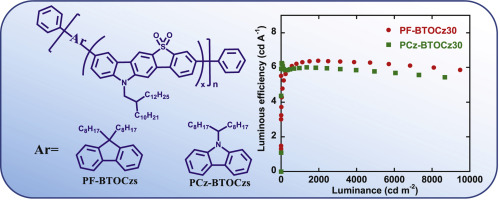Organic Electronics ( IF 3.2 ) Pub Date : 2020-02-26 , DOI: 10.1016/j.orgel.2020.105670 Yuhao Zhang , Jin Xu , Liwen Hu , Ting Guo , Ruifeng He , Wei Yang , Yong Cao

|
Blue light-emitting polymers were synthesized by Suzuki polycondensation via introducing N-(2-decyltetradecyl)carbazole[2,3-b]benzo[d] thiophene-S,S-dioxide (BTOCz) unit into the polyfluorene and polycarbazole backbone, respectively. The resulting polymers showed high thermal stability with the decomposition temperatures over 410 °C and the glass transition temperatures up to 180 °C with the increase of BTOCz content in the polymers. The lowest unoccupied molecular orbitals energy level significantly decreased, and the highest occupied molecular orbitals energy level were almost unchanged with the increasing content of BTOCz unit in the polymers. The photoluminescence quantum yields of PF-BTOCzs and PCz-BTOCzs are 45–59% and 41–54%, respectively. The device performances based on the polymers exhibited stable electroluminescent spectra with the variation of applied current densities from 100 mA cm−2 to 500 mA cm−2. The peak luminous efficiencies of 6.36 cd A−1 and 6.25 cd A−1, and the peak external quantum efficiencies of 5.03% and 4.39% with the Commission Internationale de L’Éclairage coordinates of (0.16, 0.21) and (0.17, 0.26) were obtained for PF-BTOCz30 and PCz-BTOCz30, respectively, at a turn-on voltage of 3.0 V and 2.8 V based on a single-layer device configuration of ITO/PEDOT:PSS/Emissive layer/CsF/Al. The results indicated that the strategy of introducing ambipolar BTOCz unit into the polyfluorene or polycarbazole backbone to construct the twisted molecular structure has a great potential for the development of highly efficient blue light emission.
中文翻译:

包含N-(2-癸基十四烷基)咔唑[2,3- b ]苯并[ d ]噻吩-S,S-二氧化物部分的高效蓝色发光聚合物
铃木缩聚反应通过引入N-(2-癸基十四烷基)咔唑[2,3- b ]苯并[ d ]噻吩-S,S合成蓝色发光聚合物-二氧化物(BTOCz)单元分别进入聚芴和聚咔唑骨架。随着聚合物中BTOCz含量的增加,所得聚合物在分解温度超过410°C时的玻璃化转变温度高达180°C,表现出高的热稳定性。随着聚合物中BTOCz单元含量的增加,最低的未占据分子轨道能级显着降低,而最高的占据分子轨道能级几乎不变。PF-BTOCzs和PCz-BTOCzs的光致发光量子产率分别为45–59%和41–54%。基于聚合物的器件性能表现出稳定的电致发光光谱,所施加的电流密度在100 mA cm -2到500 mA cm -2之间变化。照度为(0.16,0.21)和(0.17,0.26)的峰值发光效率为6.36 cd A -1和6.25 cd A -1,峰值外部量子效率为5.03%和4.39%基于ITO / PEDOT:PSS /发射层/ CsF / Al的单层器件配置,分别在3.0 V和2.8 V的开启电压下分别获得了PF-BTOCz30和PCz-BTOCz30的薄膜。结果表明,将双极性BTOCz单元引入聚芴或聚咔唑骨架中以构建扭曲的分子结构的策略具有开发高效蓝光的巨大潜力。



























 京公网安备 11010802027423号
京公网安备 11010802027423号